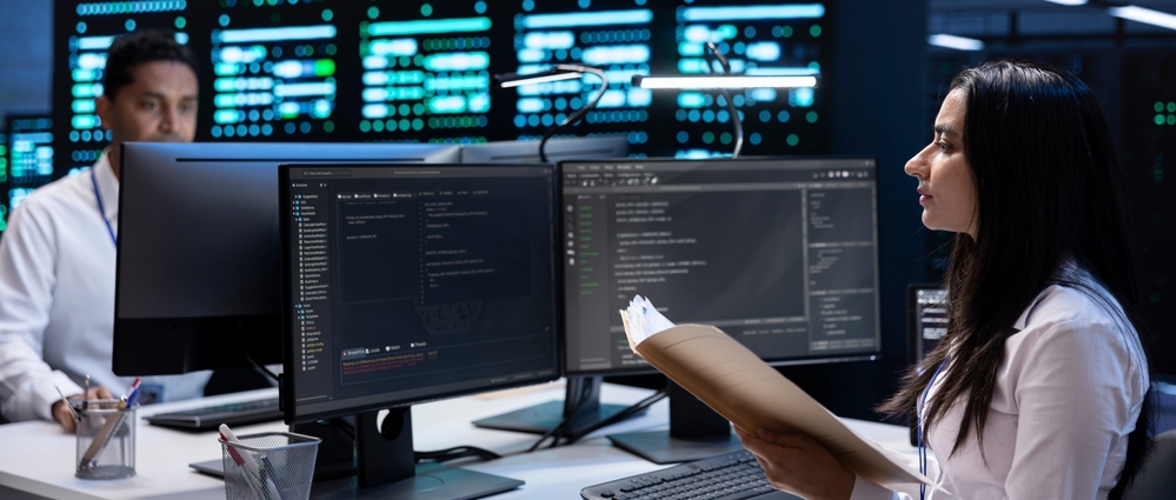Key Takeaways
- Small and medium-sized enterprises (SMEs) face increasing cyber threats due to perceived vulnerabilities, requiring a keen understanding and proactive approach to address these risks effectively.
- Despite limited resources, SMEs can fortify their cybersecurity by prioritizing various methods, all without compromising on effectiveness.
- The NIST Cybersecurity Framework empowers SMEs with structured standards across five functions, enhancing risk management, improving cybersecurity and safeguarding digital assets.
Cyberattacks are on the rise, and cybersecurity concerns are no longer exclusive to large corporations, as SMEs increasingly find themselves vulnerable to cyber threats. SMEs are often viewed as easy targets, and must understand and address these risks to safeguard integrity, ensure continuity and to foster brand trust. Despite limited resources, cost-effective strategies are available to fortify cybersecurity without compromising effectiveness.
The rise in remote work since the outbreak of COVID-19 has contributed to a surge in global cybersecurity investments. Several sectors relating to cybersecurity have experienced significant growth due to heightened demand for advanced solutions, which are often costly.
Understanding cybersecurity challenges for SMEs
If you run a small to medium business (or work with clients who do), you’ll know that SMEs often operate with limited resources, including budget constraints and lack of IT staff. These limitations make it challenging to implement comprehensive cybersecurity measures. Resource constraints also mean that a cyberattack on your SME can be particularly devastating, potentially causing significant financial losses, reputational damage and even business closure.
Understanding these challenges is the first step towards addressing them. By conducting a thorough risk assessment, recognizing your business’s vulnerabilities and the potential impacts of cyber threats, you can start to develop a proactive approach to cybersecurity, focusing on both prevention and response.
Risk analysis and risk management frameworks
Risk analysis is a crucial component of any robust cybersecurity strategy and allows you to understand your business’s vulnerabilities and prioritize defensive efforts. It's an ongoing process, as new threats emerge and business environments evolve. Regular reviews and updates are vital to maintaining the effectiveness of your cybersecurity measures. Implementing a strong risk management framework can help your business stay on top of cybersecurity risks.
How does the NIST cybersecurity framework enhance cybersecurity risk assessments?
The National Institute of Standards and Technology (NIST) provides a framework specific to managing cybersecurity threats. The NIST Cybersecurity Framework offers a set of industry standards and best practices, and comprises five core functions: Identify, Protect, Detect, Respond and Recover.
- Identify: Understand your business context, resources and risks.
- Protect: Implement safeguards to protect the delivery of critical services.
- Detect: Develop activities to identify the occurrence of a cybersecurity event.
- Respond: Take action regarding a detected cybersecurity incident.
- Recover: Restore capabilities or services impaired due to a cybersecurity incident.

This framework aligns with the risk assessment process, offering a structured approach to understanding, managing, and reducing cybersecurity risks. By adopting such a framework, your business can enhance its risk management processes, improve its cybersecurity measures and better protect its digital assets against potential threats.
Essentials of cybersecurity practices for SMEs
Incident Response Plan
An incident response plan (IRP) is an indispensable aspect of cybersecurity - NIST offers a free guide to incident management that can help you develop a tailored IRP. This plan consists of a detailed set of protocols to follow in the event of a security incident, such as a data breach, malware attack or system outage. Regular testing of the IRP is crucial to ensuring its effectiveness. You can test your IRP through tabletop exercises, which are simulations of security incidents.
The IRP should clearly outline roles and responsibilities, step-by-step processes for responding to an incident, communication plans and recovery measures. Your business should also run regular training sessions to ensure all staff members understand their roles and responsibilities during a security incident.
Employee education
Prioritizing employee education is both critical and cost-effective. Social engineering refers to any tactic used to get a person to reveal information or carry out an action that puts a business at risk, and is one of the greatest cybersecurity threats any business faces. Social engineering tactics, and human error more broadly, often serve as gateways for cyberattacks. This makes the workforce your organization's first line of defense. Conduct regular training sessions in-house or through affordable online platforms to educate employees about the various forms of cyber threats such as phishing scams, malware and ransomware.
Employees should also be taught how to identify suspicious emails, use secure passwords and practice safe internet use. This includes not downloading unverified software, avoiding clicking on unknown links and being cautious of email attachments from unfamiliar sources.
Implementing robust password policies is another simple yet effective measure. Encouraging the use of complex, unique passwords and two-factor authentication can greatly enhance account security; requiring a second form of verification in addition to a password provides an added layer of security.
In addition to these measures, your business also needs to have a comprehensive cybersecurity policy that includes guidelines on securing both physical and digital assets. You can do this with existing resources or with minimal additional expense. Every aspect of your business that interacts with the digital world should be covered under this policy, from securing Wi-Fi networks and IoT devices, to managing customer data and proprietary information.
Firewalls and antivirus software
Firewalls are a primary line of defense that monitor and control incoming and outgoing network traffic based on predetermined security rules. They act as barriers between a trusted internal network and untrusted external networks.
Antivirus software is another essential tool that helps detect, isolate and eliminate malware from a computer system. These programs scan files and systems for patterns that may indicate the presence of malicious software. They provide comprehensive protection against a range of threats, including phishing attacks, ransomware and other forms of malware.
Incorporating firewalls and antivirus software into your cybersecurity strategy allows your business to create a protective shield against cyber threats. This approach ensures a safer digital environment without overstretching your budget, allowing your business to confidently and securely operate with robust protection.
Regular software updates and patch management
Regular software updates and effective patch management not only enhance the features of existing software but also address any security vulnerabilities that may have been identified since the last update.
Software developers often release patches, which are updates meant to fix or improve their existing software. These patches can address various issues, including security vulnerabilities, bugs and other performance or usability issues. For instance, Microsoft has a regular schedule known as ‘Patch Tuesday’ for releasing updates to their software that address any identified security issues.
Patch management is a key aspect of maintaining system integrity. It involves the process of acquiring, testing and installing multiple patches on an administered computer system. This ensures that systems are updated regularly and protected against known vulnerabilities.
Secure Wi-Fi networks
Unsecured Wi-Fi networks can provide an easy entry point for cybercriminals to access sensitive company data. To secure a Wi-Fi network, you should adopt several key measures:
- Changing the network's default name and password is essential to prevent unauthorized access.
- Enabling Wi-Fi Protected Access 3 (WPA3), the latest and most secure protocol currently available, can help encrypt data on the network.
- Creating a separate network for guests or non-essential devices can further enhance security by limiting potential exposure to the company's primary network.
- Regularly updating router firmware is another important step in maintaining network security. Many manufacturers release updates to fix vulnerabilities and improve performance. You should also consider using a virtual private network (VPN) for additional security, especially when accessing the network remotely.
Data backup
Regularly backing up data ensures that your organization’s important information can be recovered in the event of a data loss incident, whether it's due to a cyberattack, hardware failure, or human error.
An on-site backup involves storing your data on local storage devices like external hard drives or servers. While this method provides quick access to backed-up data, it may not protect against physical threats like fire or theft. Cloud backup, on the other hand, involves storing data on remote servers accessible via the internet. Services like Google Cloud, Microsoft Azure and Amazon Web Services offer secure cloud storage options that are scalable and cost-effective.
Implementing a 3-2-1 backup strategy can provide robust data protection. This strategy involves keeping three copies of data, stored on two different types of media, with one copy kept offsite. Regular testing of backup procedures is also crucial to ensure your data can be effectively restored when needed. By prioritizing regular data backups, you can safeguard your business's valuable data, ensuring continuity even in the face of unforeseen incidents.
Multi-factor Authentication
Multi-factor authentication (MFA) adds an extra layer of security by requiring users to provide two or more verification factors to gain access to a resource such as an application, online account or a VPN. The most common method of MFA involves using something you know (a password), something you have (a trusted device that is not easily duplicated, like a phone) and something you are (biometrics, such as fingerprints or facial recognition).
Many services that SMEs already use, like Google Workspace, Microsoft 365 and most banking applications, offer MFA options at no additional cost. You can also integrate other inexpensive standalone MFA solutions like Duo Security and Authy with many applications for enhanced security.
Final Word
From adopting multi-factor authentication to developing an incident response plan, cybersecurity practices are fundamental to protect your business and its assets from various cyber threats. While some of these measures may seem complex or costly, there are several budget-friendly solutions and resources available that can help you improve your business’s cybersecurity posture. By investing in these essential practices, your organization can not only safeguard its operations but also build customer trust, enhance its reputation and ultimately drive growth.






